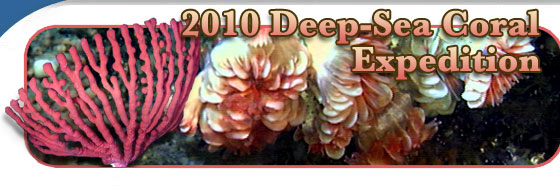Error processing SSI file
|
Blog June 29, 2010
Mary Yoklavich
Chief Scientist
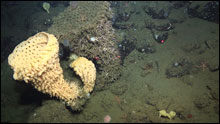 |
| Two living tan goblet sponges (Heterochone calyx) next to a dead one with brittle stars and tunicates at 500 m at the southeast side of Piggy Bank (on the tail of the pig) off southern California. Click here for a larger image. (Photo: NOAA) |
The science team for Leg 3 converged on Santa Barbara by Saturday evening (26 June). We loaded the 15 science staff (including ROV, AUV, coral and fish experts) and all of our gear via 3 RHIB (rigid hull inflatable boat) loads to the Mac and were off to our study site by 9 am on Sunday morning. We arrived on site (Piggy Bank between Anacapa and Santa Cruz Is.) around noon and began ROV ops at 2:20 pm.
The seas and weather have been outstanding...almost no swell or wind and bottom currents are also very small. By Monday evening (28 June) we have conducted 16 hrs of ROV surveys at depths 330-530 m in lovely high relief rocky habitats.
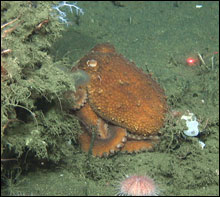 |
| An octopus next to a goblet sponge with a fragile urchin in the foreground in about 500 m on the Piggy Bank. Click here for a larger image. (Photo: NOAA) |
We have seen several taxa of corals: Christmas trees (alive and dead;
big and little; pink and white); 2 species of Primnoids; 2+ species of
Swiftia; Halipteris; Anthomastis; Telestula; some really beautiful
dense stands of Lophelia; 3 types of Paragorgiidae; Anthoptilum grandiflorum; zooanthidea; and cup corals. We have seen tons of striking sponges; these come in a variety of shapes (plates; vases; satellite dish; trumpet), sizes (tiny encrusting types on rocks to those almost a meter in height), and colors (delicate porcelain white to buttercup yellow). One is called a cloud sponge; there's also a predatory sponge! We have collected several corals for identification confirmation, and studies on genetics, internal structure, and reproduction.
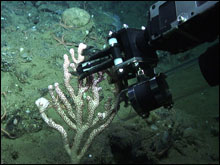 |
| ROV manipulator arm collecting a small piece of peppermint coral (Paragorgia sp.) to be used for species identification and molecular analysis. There is small anemone attached to the end of the left branch (about 450 m on the east side of Piggy Bank). Click here for a larger image. (Photo: NOAA) |
We have been collecting great High-Definition video with the ROV and we are downloading frame grabs from this video at very high resolution. In addition to corals, we have been seeing some cool fishes (which is a good thing because we have a ship-load of fish experts out here): grenadiers (aka rattails); blackfin snailfishes; deepsea sole; lots of large dover soles; a stampede of bank rockfishes and several other rockfish species (rosethorn, blackgill, stripetail, thornyheads, aurora, splitnose); a tail of a cat shark (which I think are probably very shy by nature, as we have rarely seen them in our many other visual surveys but often document their egg cases deposited on sponges, corals, and other seafloor surfaces).
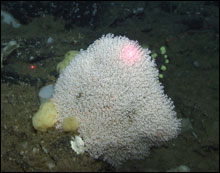 |
| A densely branching primnoid, one of the more common families of deep sea corals.
Click here for a larger image. (Photo: NOAA) |
The AUV crew from the NW and Pacific Islands Fishery Science Centers are getting ready for a second night of ops. Last night (Sunday) was spent in very challenging habitats (10s of meters high rock columns on top of the bank). The AUV collected hundreds of really beautiful high resolution photos that are going to be very useful in presenting a landscape view of the coral community, and will be coupled with the ROVs high-resolution video surveys to ground truth identifications of corals and fishes. The Lophelia coral stands are especially interesting when viewed from the broader perspective of the AUV. Tonight the AUV crew is surveying an underwater valley on the north side of the bank at about 600 meters depth.
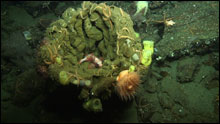 |
| Splitnose rockfish (Sebastes diploproa) in a goblet sponge, which is habitat for other organisms including anemones, brittle stars, sponges, and crabs. Click here for a larger image. (Photo: NOAA) |
We have been successful in collecting water samples associated with the coral surveys. In addition to the water samples, we collect information on temperature, salinity, dissolved oxygen, and pH. The research coordinator for the Channel Islands National Marine Sanctuary made a special trip to the ship this evening to deliver one of our oxygen sensors (that was 60 miles roundtrip across the Santa Barbara Channel with night approaching...Thanks Steve!). We are making a CTD cast and water collection at the beginning and end of each day's ROV ops. In addition, we have integrated oxygen and ph sensors into a CTD on the ROV. This should give a good idea of the water chemistry associated with the coral communities and a baseline for monitoring ocean acidification.
That's it for now. Time for bed onboard the McArthur II.
|

